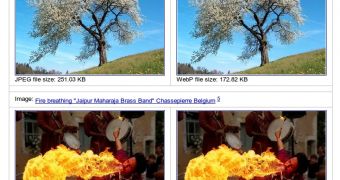Google has provided some updates on its WebP image format, introduced a little over half a year ago. WebP is a lossy image format that is designed to create smaller image files with comparable or better quality to other lossy formats, meaning JPEG, in practice.
The team has been working on improving image quality and speed when decoding WebP images in an app that supports it.
For encoding, the concept of multiple-zone compression has been introduced resulting in smaller and better looking images. More web and native apps now support the format as well.
"WebP's compression algorithms have been significantly improved while remaining completely compatible with the previous releases," Posted by Richard Rabbat, Product Manager and Pascal Massimino, Software Engineer at Google, announced.
"On the decoding side, we have integrated a fancy upsampler. Fancy upsampling reduces the pixelation of strong edges," they explained. The improved upsampler means that zoomed in images will look significantly better.
A new feature introduced comes in rather handy when connection speeds are low, for example on mobile devices. Images can now be partially decoded before they've finished downloading, meaning that a browser can display something even if the image is not ready yet. This already works in Chrome 12.
"On the encoding side, to further improve quality, we focused on segmenting the picture into areas with similar compressibility. For each of these segments, we tune the amount of compression and filtering differently, and bits are redistributed where they are most useful," Google explained.
WebP encoders can now split a source image into as many as four areas and apply different compression settings to them. This is similar to a variable bitrate MP3 audio file, more data is used for portions where it makes more sense to, for images, the portions that are more detailed, for audio files, regions where more sounds are layered.
The team is now working on adding alpha channel support to the format, a feature missing from the JPEG standard, but available in the lossless PNG or the older GIF, the other two popular image formats on the web.
This would allow the creation of transparent images, useful for web design, icons and so on. Of course, a lossy image format is probably not going to be that great for designers, especially if an alpha channel is involved.
Along with the improvements, the WebP format is being adopted and used by more websites and applications. Google's own apps, including Gmail and Picasa Web Albums now support WebP images. Google also uses the format to store Instant Previews.
Software support for WebP is on the rise as well, there is a plugin for Photoshop and Windows, Mac OS X and Linux users can install packages that add support at the OS level.

 14 DAY TRIAL //
14 DAY TRIAL //